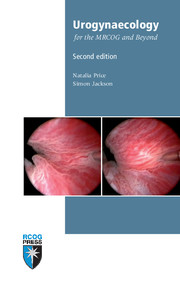Book contents
- Frontmatter
- Contents
- Preface
- Abbreviations
- 1 Applied anatomy and physiology of the lower urinary tract
- 2 Definition and prevalence of urinary incontinence
- 3 Initial assessment of lower urinary tract symptoms
- 4 Further investigation of lower urinary tract symptoms
- 5 Management of stress urinary incontinence
- 6 Management of overactive bladder syndrome
- 7 Recurrent urinary tract infection
- 8 Haematuria
- 9 Painful bladder syndrome and interstitial cystitis
- 10 Pregnancy and the renal tract
- 11 Ageing and urogenital symptoms
- 12 Fistulae and urinary tract injuries
- 13 Pelvic organ prolapse
- 14 Colorectal disorders
- 15 Obstetric anal sphincter injuries
- Index
5 - Management of stress urinary incontinence
Published online by Cambridge University Press: 05 July 2014
- Frontmatter
- Contents
- Preface
- Abbreviations
- 1 Applied anatomy and physiology of the lower urinary tract
- 2 Definition and prevalence of urinary incontinence
- 3 Initial assessment of lower urinary tract symptoms
- 4 Further investigation of lower urinary tract symptoms
- 5 Management of stress urinary incontinence
- 6 Management of overactive bladder syndrome
- 7 Recurrent urinary tract infection
- 8 Haematuria
- 9 Painful bladder syndrome and interstitial cystitis
- 10 Pregnancy and the renal tract
- 11 Ageing and urogenital symptoms
- 12 Fistulae and urinary tract injuries
- 13 Pelvic organ prolapse
- 14 Colorectal disorders
- 15 Obstetric anal sphincter injuries
- Index
Summary
NICE recommends that women with urinary incontinence be categorised according to their symptoms into three groups: stress, mixed or urge urinary incontinence. Overall, approximately one-half of all women with urinary incontinence complain of pure stress incontinence and 30–40% have mixed symptoms of stress and urge incontinence. Women with mixed urinary incontinence, who have involuntary leakage associated with urgency and also with exertion, should have initial treatment targeted to the symptom that they report to be the most troublesome.
Stress incontinence is the complaint of involuntary leakage on effort or exertion, or on sneezing or coughing, and suggests a problem with urethral competence. Urodynamic stress incontinence may be noted during filling cystometry and is defined as the involuntary leakage of urine during increased abdominal pressure, in the absence of a detrusor contraction. Prevalence figures for urinary incontinence vary widely. It is thought that urinary loss secondary to urodynamic stress incontinence is slightly more common than that secondary to detrusor overactivity. These two conditions account for the vast majority of female incontinence in the developed world, although globally fistulae from obstructed labour is another major cause.
Aetiology
The aetiology of stress incontinence is undoubtedly multifactorial. Some women appear to have a congenital predisposition, possibly because of inherently weak collagenous connective tissue. Childbirth has always been known to be a major contributory factor, although robust clinical data confirming this is remarkably sparse. Other contributory factors such as the menopause are more contentious. Anything that places chronic strain on the pelvic floor may also predispose to urinary stress incontinence; such factors include constipation, obesity and chronic cough.
- Type
- Chapter
- Information
- Urogynaecology for the MRCOG and Beyond , pp. 37 - 46Publisher: Cambridge University PressPrint publication year: 2012
- 2
- Cited by

